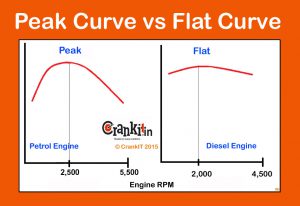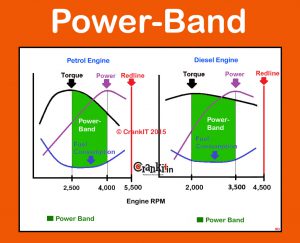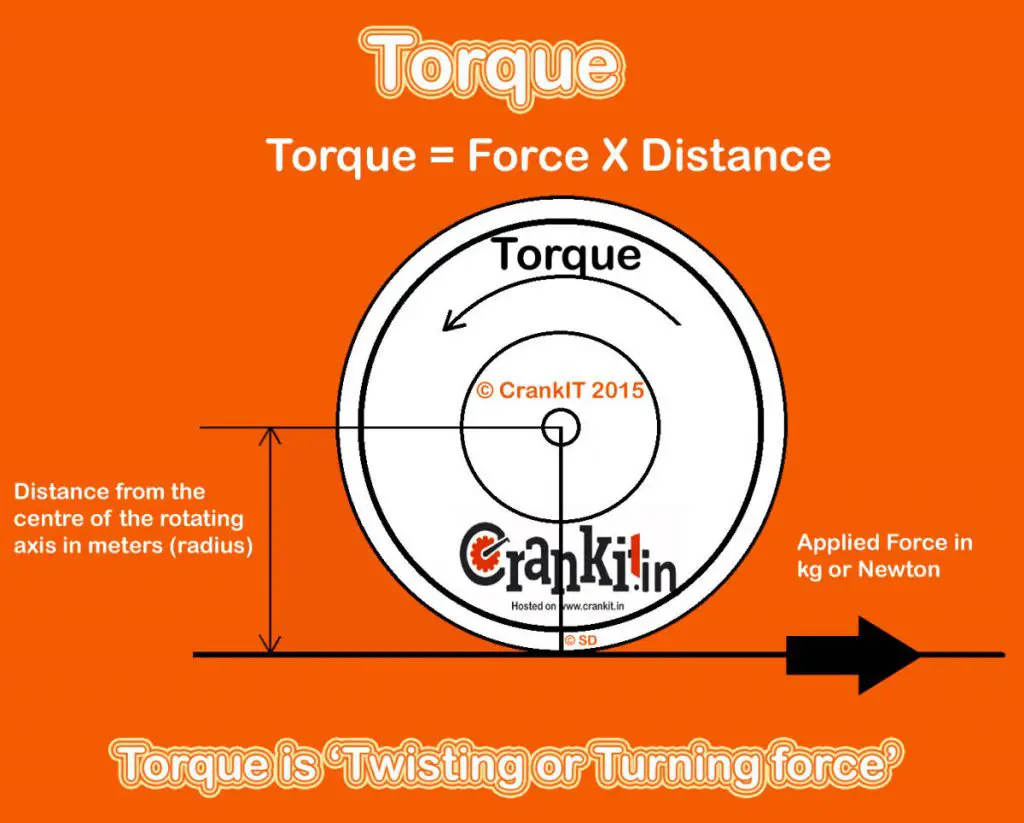Engine Torque Definition and Formula:
What is Engine Torque?
Torque, in simple terms, is ‘Twisting or Turning Force.’ By definition, the force tends to rotate an object about an axis. In automotive terms, it measures rotational effort applied on the engine crankshaft by the piston.
Torque= Force x Distance. The SI system uses Newton-metre (Nm) to measure the torque. The other units are kilogram-meter (Kg-m) in metric and feet-pound-force‘ (ft-lb) in imperial/British units.
Every engine is designed and built for a specific purpose. Hence, its output varies depending upon its application. The torque output of an automotive engine mainly depends on its stroke-to-bore ratio, compression ratio. Besides, it also depends on combustion pressures & speed in rpm. Most ‘under-square’ engines with higher stroke length than their bore diameter tend to develop a lot of ‘low-end torque.’ The torque that an engine can exert depends on the engine speed or RPM.
Different engine designs/configurations develop divergent torque characteristics such as peak curve/flat curve. Most automotive engines produce a sound torque output within a narrow band of the engine’s entire speed range. In petrol engines, it characteristically starts at around 1000-1200 rpm and reaches a peak in the range of 2,500–4,000 rpm. In contrast, a diesel engine starts at about 1500-1700 rpm and peaking at 2000-3000 rpm. Bugatti Veyron is one of the cars in the world with the highest torque figures.

How To Calculate Engine Torque?
If you know the Horse-Power of the engine, then you can use the following formula –
Torque= 5252 x HP/RPM
Why Is It So Important?
Torque and Horse-Power are the twin outputs of an engine. They are related and proportional to each other by speed. The ‘torque-band‘ in an engine curve represents its pulling ability. It determines a vehicle’s ‘driveability‘ & ‘acceleration.’ Torque is most needed while moving a vehicle from the standstill and/or climbing a slope.
Similarly, heavier is the vehicle or a vehicle with full rated load requires a higher amount of torque to pull it and get it moving. In a conventional engine, the horsepower governs the vehicle’s top speed (thru’ gear ratios). However,, the torque controls its acceleration/pick-up. The rate of acceleration also depends on the vehicle’s weight and the ‘load’ carried by the vehicle.
Flat-Curve vs Peak-Curve:
Most petrol engines typically produce a considerably high ‘low-end torque.’ However, usually, they exhibit ‘peak-curve’ torque in the shape of the ‘peak’ of a hill. In the ‘peak-curve’ design, the torque peaks at the middle of the engine speed range (around 2500-3000 rpm). After this, it starts to fade out rapidly while the horsepower still keeps rising. As a result, the HP reaches its maximum value later at a higher engine rpm and fades out at the red line.

Most modern diesel engines deliver a ‘flat-curve‘ torque. In ‘flat-curve’ design, the motor produces maximum torque at a ‘lower-to-middle-end‘ of its speed, i.e., approx. 1500 rpm onward. Its value remains almost the same or ‘flat’ across most of the engine speed ranges (2500-4000 rpm). Thus, it helps in better acceleration and effects fewer gear shifts while driving.
What is Low-End Torque?
Often manufacturers use this term to describe a motor’s torque performance. ‘Low-End-Torque‘ is the engine’s torque at the lower engine speed band, i.e., between 1000-2000 rpm. This rpm band is very crucial when moving a vehicle from a standstill or driving in slow-speed conditions such as in traffic.
If the motor generates a more significant amount of torque at the lower end of the rpm band, it implies that the motor has higher ‘low-end torque’ or better pulling-ability at slow speeds. It also means that the engine can move the vehicle quickly from a standstill, pull heavier loads, or climb a slope relatively easily, as the case may be, without revving hard.
Engine Torque and Efficiency:
Then, the torque reaches its peak value at a speed where it is most efficient. In other words, the engine efficiency is at the maximum at a speed where it produces its peak-torque. If you raise the motor above this speed, its torque starts to decrease because of the increased friction of the moving parts. So even if you rev the motor over & above the peak-torque speed, the torque doesn’t increase any further.
The vehicle’s gearbox multiplies the engine’s torque. Therefore, the lower the gear selected (i.e., 1st gear, which has a high gear ratio), the greater is the engine’s pulling ability. Thus, the vehicle’s pulling ability is highest in the first gear. However, if you rev the engine further in 1st gear, it reaches its limit after some time, prompting the driver to shift to the next gear. In contrast, the vehicle might lose its acceleration if you change gears before the engine torque reaches its ‘peak’ value. As a result, the wheels would not get enough force to rotate. Thus, it compels the driver to shift back to the previous/lower gear.
Driving:
You can obtain the best fuel efficiency by changing the gears within the vehicle’s ‘Power-Band‘ and as close to the peak torque value as possible. Also, to get better efficiency, select the correct gear/s corresponding to the vehicle speed/engine rpm as recommended by the vehicle manufacturer.
1. Highway Scenario:
Topmost available Gear (i.e., 5th or 6th or so on) + Lowest Engine Speed = Best Fuel Efficiency
2. When climbing a slope/gradient:
Low gear (i.e., 1st) + High engine speed = Least Fuel Efficiency but more pulling ability.
Once your vehicle goes past 60 Km/h, such as on the highway, you do not need high engine rpm to keep it going. So, while cruising on highways/motorways, use the topmost gear and keep the engine rpm below 2500 to get maximum efficiency. Similarly, while climbing a slope, you need to use the lower gear (i.e., 1st gear) and higher engine rpm to pull the vehicle (and load, if any) against the force of gravity. Again, however, it will affect the fuel efficiency.

Every Owner’s Manual mentions these values. Having said this, always running the engine on ‘max-power/speed‘ or revving the engine to the ‘Red Line’ zone is not necessary unless you are running a race. And, it will only result in the burning of extra fuel & loss of mileage.
Remember that such extra fuel, either burned or saved, will make a lot of difference at the end of the journey – be it short or long.!!!
Read more: What is Horse Power?

